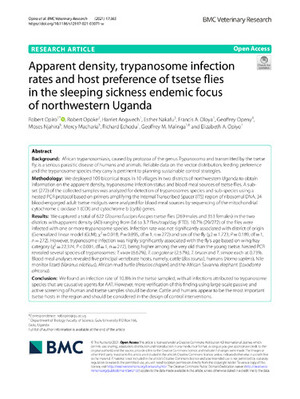
Characterisation of the wildlife reservoir community for human and animal trypanosomiasis in the Luangwa Valley, Zambia
Abstract
Animal and human trypanosomiasis are constraints to both animal and human health in Sub-Saharan Africa, but there is little recent evidence as to how these parasites circulate in wild hosts in natural ecosystems. The Luangwa Valley in Zambia supports high densities of tsetse flies (Glossina species) and is recognised as an historical sleeping sickness focus. The objective of this study was to characterise the nature of the reservoir community for trypanosomiasis in the absence of influence from domesticated hosts.
A cross-sectional survey of trypanosome prevalence in wildlife hosts was conducted in the Luangwa Valley from 2005 to 2007. Samples were collected from 418 animals and were examined for the presence of Trypanosoma brucei s.l., T. b. rhodesiense, Trypanosoma congolense and Trypanosoma vivax using molecular diagnostic techniques. The overall prevalence of infection in all species was 13.9% (95% confidence interval [CI]: 10.71–17.57%). Infection was significantly more likely to be detected in waterbuck (Kobus ellipsiprymnus) (Odds ratio [OR] = 10.5, 95% CI: 2.36–46.71), lion (Panthera leo) (OR = 5.3, 95% CI: 1.40–19.69), greater kudu (Tragelaphus strepsiceros) (OR = 4.7, 95% CI: 1.41–15.41) and bushbuck (Tragelaphus scriptus) (OR = 4.5, 95% CI: 1.51–13.56). Bushbucks are important hosts for T. brucei s.l. while the Bovidae appear the most important for T. congolense. The epidemiology of T. vivax was less clear, but parasites were detected most frequently in waterbuck. Human infective T. b. rhodesiense were identified for the first time in African buffalo (Syncerus caffer) and T. brucei s.l. in leopard (Panthera pardus). Variation in infection rates was demonstrated at species level rather than at family or sub-family level. A number of significant risk factors interact to influence infection rates in wildlife including taxonomy, habitat and blood meal preference.
Trypanosoma parasites circulate within a wide and diverse host community in this bio-diverse ecosystem. Consistent land use patterns over the last century have resulted in epidemiological stability, but this may be threatened by the recent influx of people and domesticated livestock into the mid-Luangwa Valley.
Citation
Anderson, N.E., Mubanga, J., Fèvre, E.M., Picozzi, K., Eisler, M.C. and Thomas, R. 2011. Characterisation of the wildlife reservoir community for human and animal trypanosomiasis in the Luangwa Valley, Zambia. PLOS Neglected Tropical Diseases 5(6): e1211.









